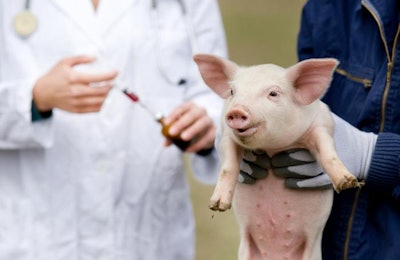
The Pig Veterinary Society (PVS) is adopting the European Medicines Agency’s (EMA) list of highest-priority Critically Important Antibiotics (CIAs), namely fluoroquinolones, third and fourth generation cephalosporins and colistin. The decision followed a review carried out by its medicines sub-committee.
The PVS has a policy to review guidelines and antibiotic classes as new information comes to light. The latest review coincides with a move last month from RUMA, the agricultural and food industry alliance which promotes responsible use of medicines in farm animals, to align with the EMA position.
The announcement means that under PVS guidelines, fluoroquinolones, third and fourth generation cephalosporins and colistin will retain Class 3 status. This means they are only used when no other options are available and when supported by laboratory sensitivity testing – or exceptionally when all other options have failed.
Guidelines for using antibiotics with pigs
Class 1 antibiotics form the standard prescribing list within responsible use guidelines and Class 2 are used only when sensitivity tests or clinical experience proves standard antibiotics are not effective. In all treatment decisions, the health and welfare of the pigs must always take priority.
Betalactams with betalactamase inhibitors (clavulanic acid) were previously in the highest priority Class 3 but in light of the list defined by the EMA, which has been adopted by the Veterinary Medicines Directorate as well as RUMA, the PVS has reassessed the risk and moved them to Class 2 to align them with plain betalactams. This means they are still subject to voluntary restrictions, but their use would not necessarily be only as a last resort.
PVS president Mark White explains despite the ongoing review process and the potential to reclassify certain products, the Society’s underlying principles remain unchanged.
“The total amount of all antibiotics used on pig farms to treat and prevent disease should be minimised, and the types of antibiotics used in pigs should be considered in light of the implications for antibiotic resistance challenges in both pigs and man,” he said.
“This policy is proving successful with AHDB Pork’s electronic pig medicine book (e-MB) recently showing that use of colistin appears to have fallen by over 70 percent in 2016 following its move to a Class 3 antibiotic in late 2015.
“We must also continue to be alert to the possibility of cross resistance, even in older antibiotics that have little or no use in humans. Risk must be acknowledged where it exists and overall reductions are still imperative.”
RUMA has welcomed the review and alignment from the PVS. Secretary General John FitzGerald says: “Farmers and vets need boundaries within which to operate and clear objectives to meet, and we would urge all supply chains, from farmer to retailer, to align with the sector position on best practice use of antibiotics, as defined by each sector’s professional veterinary organisation.”

















